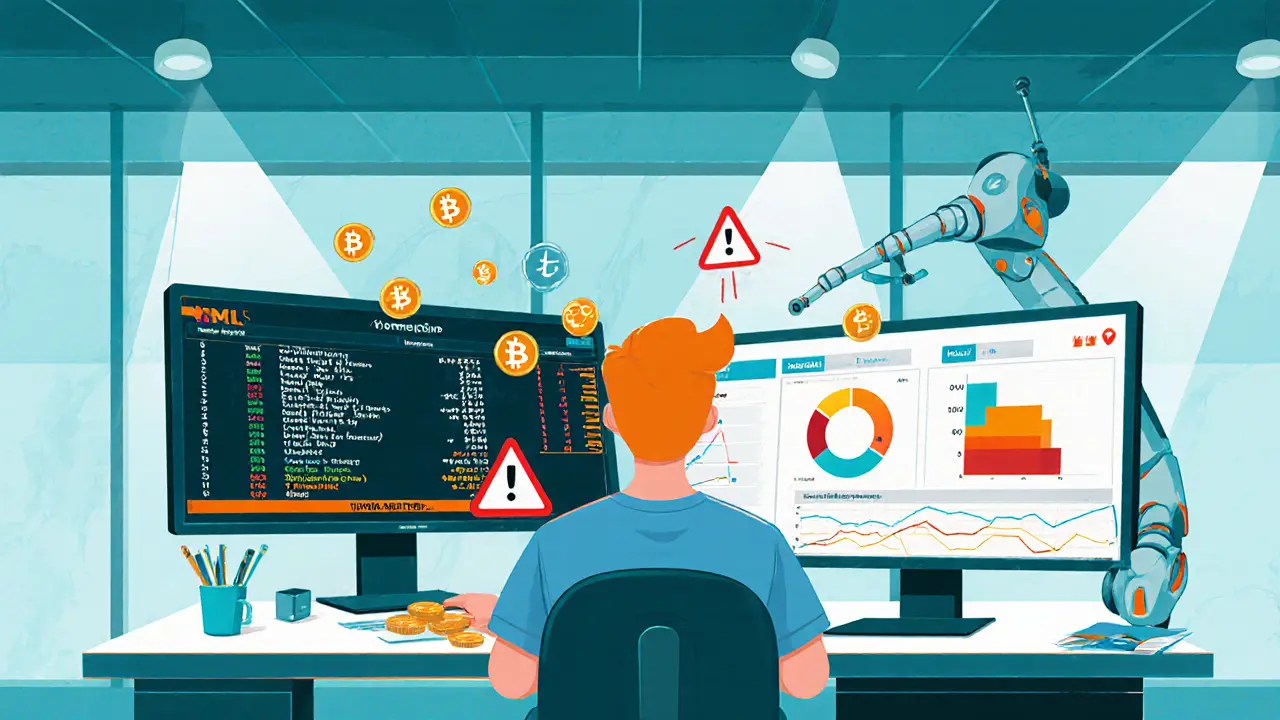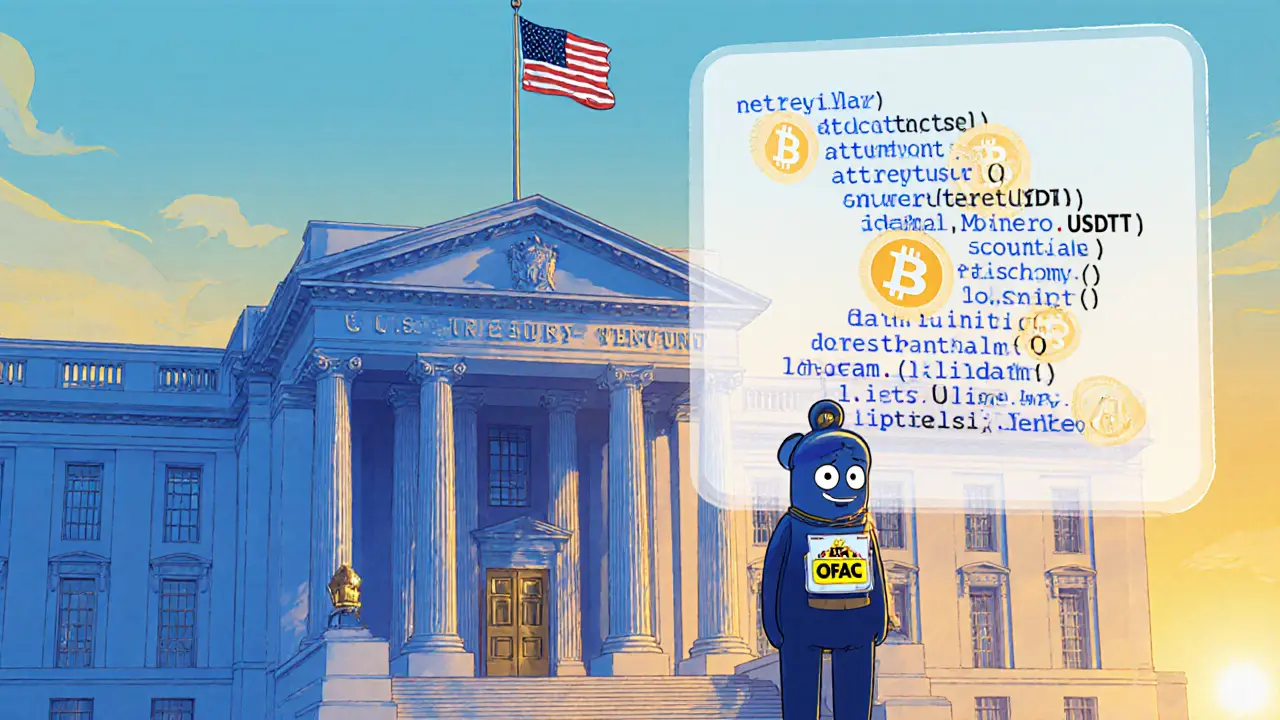OFAC Crypto Sanctions Compliance Calculator
Assess Your Transaction Risk
Check the compliance risk level of your crypto transactions based on OFAC's sanctions data. This tool helps you understand potential fines and compliance requirements for different cryptocurrencies.
Compliance Assessment
Transaction Risk Level:
Low RiskCompliance Requirements:
Ensure all transactions are monitored against OFAC's SDN list and comply with AML protocols.
Potential fines: $0 - $100,000 (Based on transaction size)
Recommended Actions:
- Subscribe to OFAC's XML feed
- Implement real-time transaction monitoring
- Verify all 17 sanctioned crypto types are supported
Additional Notes:
Most exchanges complete OFAC compliance implementation within 3-6 months.
Office of Foreign Assets Control (OFAC) is the U.S. Treasury unit that publishes and enforces economic sanctions. As of 2025 the agency has added more than 1,200 cryptocurrency wallet addresses to its Specially Designated Nationals (SDN) list, targeting everything from Bitcoin to stablecoins. If you run an exchange, a DeFi platform, or even a small crypto‑wallet service, understanding how OFAC sanctions work can save you from hefty fines and legal trouble.
Why OFAC started policing crypto
Traditional sanctions hit banks and corporations, but digital money lets bad actors hop across borders with a click. OFAC realized early 2020s that illicit actors were using crypto to evade detection, so it began expanding its reach. In 2024 the agency added guidance for real‑time monitoring, and by early 2025 it even started sanctioning Decentralized Autonomous Organizations (DAOs) and autonomous trading bots. The goal remains the same: block designated individuals, entities, and countries from tapping into the U.S. financial system.
How the crypto sanctions list is built
The core of the system lives in an XML file called sdn_advanced.xml. Every 15 minutes the file gets refreshed with new wallet addresses, entity names, and risk scores. The file can be converted to plain‑text (one address per line) or JSON for easier ingestion by monitoring tools. Each entry carries a risk score that ranges from 1 (low) to 10 (critical), helping platforms prioritize alerts.
Crypto types covered by OFAC
| Crypto | Symbol | Primary Use | Sanction Risk |
|---|---|---|---|
| Bitcoin | XBT | Store of value, payments | High |
| Ethereum | ETH | Smart contracts, DeFi | High |
| Monero | XMR | Privacy‑focused transfers | Very High |
| USD Tether | USDT | Stablecoin, cross‑border | Medium |
| Tron | TRX | DeFi, dApps | Medium |
That list keeps growing. By mid‑2025 OFAC added layer‑2 networks like Arbitrum and Binance Smart Chain to close gaps where illicit funds could slip through.
Real‑time screening tools you need
Compliance teams now look for providers that can ingest the XML feed, parse addresses, and push alerts into transaction monitoring systems within minutes. Scorechain is one of the market leaders, boasting a 15‑minute update window. Other notable tools include Chainalysis, CipherTrace, and the newer DeFi‑focused scanners endorsed by OFAC in March 2025. When choosing a solution, ask yourself:
- Does it support all 17 crypto types listed by OFAC?
- Can it handle JSON, CSV, and XML outputs?
- Is the risk‑score algorithm transparent?
- Does it offer API endpoints for automated flagging?

Case study: sanctioned Iranian oil profits
In September 2025 OFAC named two Iranian nationals - Alireza Derakhshan and Arash Estaki Alivand - for moving over $100 million of oil revenue through Ethereum and TRON wallets. Their addresses were publicly listed, yet they kept creating fresh wallets on privacy‑coin networks to hide traces. The crackdown forced exchanges to block any transaction linked to those addresses, showing how quickly a well‑fed compliance engine can freeze illicit flow.
Case study: the Garantex takedown
Garantex was a European exchange accused of laundering crypto for sanctioned parties. After a joint U.S., German, and Finnish operation in March 2025, over $26 million in Bitcoin and Ethereum were seized. The exchange tried to re‑brand as “Grinex,” but OFAC promptly added the new entity to the SDN list, illustrating that renaming alone won’t dodge sanctions.
How exchanges implement compliance
Typical rollout looks like this:
- Ingest the sdn_advanced.xml feed into a staging database.
- Map each address to the blockchain(s) you support (BTC, ETH, BSC, etc.).
- Apply risk scores and flag any inbound or outbound transaction that touches a sanctioned address.
- Trigger AML alerts for review and potentially freeze the funds.
- Report the incident to the U.S. Treasury’s Office of Foreign Assets Control within the mandated timeframe (usually 24 hours).
Most midsize exchanges finish this in 3‑6 months, but larger platforms may need a year to perfect multi‑chain coverage.

Dealing with privacy coins and evasion tactics
Monero, Zcash, and other privacy‑focused assets pose a special headache because their transaction data is deliberately obscured. OFAC’s current list only includes known wallet hashes, but criminals can generate fresh keys at will. The best defense is to monitor “mixing services” and enforce stricter KYC/AML on any user who wants to convert into privacy coins.
Practical checklist for compliance officers
- Subscribe to OFAC’s XML feed and set up an automated pull every 10 minutes.
- Validate that your monitoring engine supports all 17 sanctioned crypto types.
- Maintain a separate audit log for every address flagged, including timestamps and risk scores.
- Train your AML analysts on the latest case studies (e.g., Garantex, Lazarus Group).
- Prepare a pre‑written SAR (Suspicious Activity Report) template for rapid filing.
Follow this list and you’ll stay ahead of most enforcement actions.
Future outlook
OFAC plans to broaden its reach to AI‑driven trading bots, smart‑contract developers, and more layer‑2 solutions. Proposed May 2025 regulations could even hold DeFi protocol creators personally liable if they enable sanctioned addresses to move funds. Keeping your compliance stack modular and API‑first will make it easier to adapt when new rules drop.
What is the SDN list and why does it matter for crypto?
The Specially Designated Nationals (SDN) list is a roster of individuals, entities, and wallet addresses that the U.S. Treasury has identified as supporting illicit activity. Any transaction involving a listed address is illegal for U.S. persons and can trigger enforcement, fines, or asset seizure.
How often does OFAC update the crypto address file?
Since the 2025 Crypto Compliance Guidance, the XML feed is refreshed at least every 15 minutes, ensuring that new designations appear almost in real time.
Can I rely on a single compliance tool for all 17 cryptocurrencies?
Most leading tools now cover the full list, but you should verify support for layer‑2 networks (Arbitrum, BSC) and privacy coins, which may need supplemental scanners.
What happens if I accidentally process a transaction with a sanctioned address?
You must freeze the funds, report the incident to OFAC within 24 hours, and cooperate with any investigative authority. Penalties can range from civil fines to criminal prosecution.
Are privacy coins like Monero also tracked?
Only known wallet hashes appear on the SDN list. Because Monero hides transaction data, regulators focus on the exchanges that convert into or out of privacy coins and enforce stricter KYC on those pathways.

13 Comments
madhu belavadi
lol who even uses OFAC anymore? I just send my crypto through 5 mixers and call it a day. they're so behind.
Dick Lane
Honestly this is one of the clearest guides I've seen on crypto sanctions. The XML feed details alone are worth bookmarking. Been using Scorechain for 8 months and it's saved my team from a potential audit nightmare.
Big props to whoever put this together.
Norman Woo
you guys realize this is all a psyop right? OFAC doesn't even track addresses they just make up names to scare people into using fiat
the real sanctions are in the banks and the fed. blockchain is just a distraction so they can monitor your every move through your phone
they know your wallet before you even create it trust me i've seen the docs
Serena Dean
This is such a solid breakdown! I've been helping small DeFi startups get compliant and this checklist? Chef's kiss.
Especially the part about training AML analysts on Lazarus Group cases - that's something so many teams overlook. If you're not studying the bad guys, you're just guessing.
Also shoutout to the 15-minute XML refresh - that’s the kind of real-time thinking we need more of.
James Young
Most of you are missing the point. This isn't about 'compliance' - it's about control. OFAC doesn't care if you're clean, they care if you're obedient. The risk scores? Arbitrary. The XML feed? A trap. They want you dependent on their tools.
And if you're using Scorechain or Chainalysis? You're already compromised. You're handing them your transaction graph on a silver platter.
Real crypto means self-custody, no monitoring, no reporting. Anything else is just banking with extra steps.
Chloe Jobson
Layer-2 coverage is critical. We missed Arbitrum for 3 weeks last year and got flagged. Now we auto-parse all 17 types + L2s via API.
Also - SAR template is non-negotiable. Pre-written, pre-approved, pre-loaded. Saves 4 hours per incident.
Andrew Morgan
Man I remember when crypto was just about freedom and now we're stuck in this compliance circus
Every time I see another wallet get added to that list I just shake my head
They turned the wild west into a DMV with blockchain
Still love the tech though. Just wish we could be free without jumping through 17 hoops
Michael Folorunsho
Why are we even talking about this? The U.S. is the only country with real enforcement power. Europe? A joke. India? Paper tiger. If you're not complying with OFAC, you're not just risky - you're unpatriotic.
And Monero? That's not crypto, that's a criminal toolkit. Anyone using it should be on the list.
Roxanne Maxwell
Thank you for writing this. I'm a compliance officer in a small firm and this made me feel less alone.
Also, the Garantex case study? Chilling. I showed it to my team yesterday. We all had that moment where we realized - this could be us if we slip up.
Jonathan Tanguay
Ok so let me just say this because nobody else seems to get it - the OFAC XML feed is not updated every 15 minutes, that's a myth pushed by Chainalysis to sell more licenses. The real feed is delayed by 2-4 hours because of bureaucratic bottlenecks and manual review. I've been scraping it since 2023 and I've seen the logs. They don't even auto-parse the new addresses, they have to be manually vetted by some guy in a cubicle in Washington. So if you think you're getting real-time data, you're delusional. Also the risk scores? Totally made up, no algorithm, just guesswork based on how many times the address showed up on a dark web forum. And don't even get me started on how they classify TRON as 'medium' risk - that's laughable, it's been used for scams since day one. And the part about DAOs being sanctioned? That's not even legally enforceable, it's just a press release with a fancy label. The whole system is a house of cards held together by fear and FUD.
Ayanda Ndoni
So what do I do if I'm in South Africa and just want to swap some BTC for USDT without getting my bank account frozen?
Do I just give up?
Elliott Algarin
It's funny how we're building this whole infrastructure to stop bad actors, but we're still treating crypto like it's a bank.
What if the answer isn't more monitoring, but less reliance on centralized control?
Maybe the real compliance is in designing systems where sanctions don't need to be enforced - because they're irrelevant by design.
John Murphy
Anyone know if the sdn_advanced.xml includes the timestamp of when each address was added? I'm trying to correlate with blockchain activity to see if there's a pattern in when new sanctions drop - like right after a big exchange listing or a memecoin pump